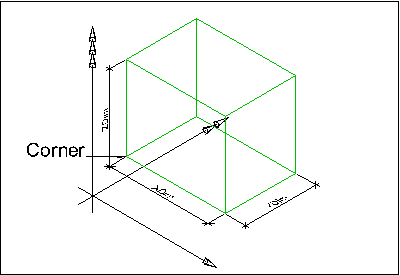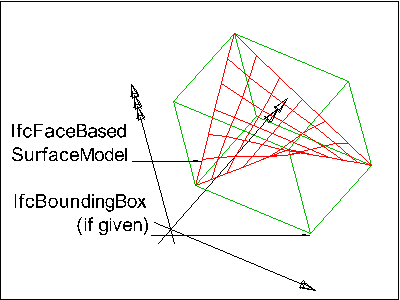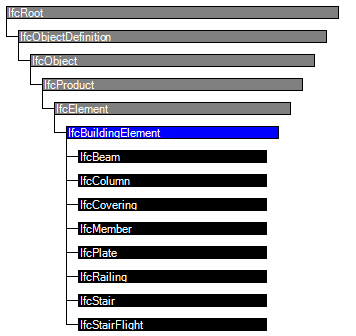Semantic definitions at the entity
Entity definition
Definition from ISO 6707-1:1989: Major functional part of a building, examples are foundation, floor, roof, wall.
The building element comprises all elements that are primarily part of the construction of a building, i.e., its structural and space separating system.
EXAMPLEs of building elements are walls, beams, or doors, they are all physically existent and tangible things.
The IfcBuildingElement utilizes the following capabilities mainly through inverse attributes referencing objectified relationships:
- Grouping - being part of a logical group of objects
- objectified relationship: IfcRelAssignsToGroup
- inverse attribute: HasAssignment
- Work processes - reference to work tasks, in which this
building element is used
- objectified relationship: IfcRelAssignsToProcess
- inverse attribute: HasAssignments
- Aggregation - aggregated together with other elements
to form an aggregate
- objectified relationship: IfcRelAggregates
- inverse attribute (for container): IsDecomposedBy
- inverse attribute (for contained parts): Decomposes
- Material - assignment of material used by this building
element
- objectified relationship: IfcRelAssociatesMaterial
- inverse attribute: HasAssociations
- Classification - assigned reference to an external
classification
- objectified relationship: IfcRelAssociatesClassification
- inverse attribute: HasAssociations
- Documentation - assigned reference to an external
documentation
- objectified relationship: IfcRelAssociatesDocumentation
- inverse attribute: HasAssociations
- Type - reference to the common product type information
for the element occurrence
- objectified relationship: IfcRelDefinesByType
- inverse attribute: IsDefinedBy
- Properties - reference to all attached properties,
including quantities
- objectified relationship: IfcRelDefinesByProperties
- inverse attribute: IsDefinedBy
- Connection - connectivity to other elements, including
the definition of the joint
- objectified relationship: IfcRelConnectsElements
- inverse attribute: ConnectedTo
- inverse attribute: ConnectedFrom
- Realization - information, whether the building element
is used to realize a connection (e.g. as a weld in a
connection between two members)
- objectified relationship: IfcRelConnectsWithRealizingElements
- inverse attribute: IsConnectionRealization
- Ports - information, whether the building element has
ports for system connections (note: normally not used, this
relationship is inherited from IfcElement and mainly
applicable to IfcDistributionElement's)
- objectified relationship: IfcRelConnectsPortToElement
- inverse attribute: HasPorts
- Assignment to spatial structure - hierarchical
assignment to the right level within the spatial structure
- objectified relationship: IfcRelContainedInSpatialStructure
- inverse attribute: ContainedInStructure
- Reference to spatial structure(s) - non hierarchical
reference to one or more elements within the spatial
structure (e.g. a curtain wall, being contained in the
building, references several stories)
- objectified relationship: IfcRelContainedInSpatialStructure
- inverse attribute: ContainedInStructure
- Boundary - provision of space boundaries by this
building element
- objectified relationship: IfcRelSpaceBoundary
- inverse attribute: ProvidesBoundaries
- Coverings - assignment of covering elements to this
building element (note: normally covering elements are
assigned to the space, only used for special cases)
- objectified relationship: IfcRelCoversBldgElements
- inverse attribute: HasCoverings
- Voids - information, whether the building element
includes openings, recesses or other voids
- objectified relationship: IfcRelVoidsElement
- inverse attribute: HasOpenings
- Projection - information, whether the building element
has projections (such as a fascia)
- objectified relationship: IfcRelProjectsElement
- inverse attribute: HasProjections
- Filling - information whether the building element is
used to fill openings
- objectified relationship: IfcRelFillsElement
- inverse attribute: FillsVoids
- Structural member reference - information whether the
building element is represented in a structural analysis
model by a structural member
- objectified relationship: IfcRelConnectsStructuralElement
- inverse attribute: HasStructuralMember
HISTORY New entity in IFC Release 1.0
Quantity Use Definition:
The quantities relating to the IfcBuildingElement are defined by the IfcElementQuantity and attached by the IfcRelDefinesByProperties. A detailed specification for individual quantities is introduced at the level of subtypes of IfcBuildingElement.
Geometry Use Definitions
The geometric representation of any IfcBuildingElement is given by the IfcProductDefinitionShape and IfcLocalPlacement allowing multiple geometric representations.
Local Placement
The local placement for any IfcBuildingElement is defined in its supertype IfcProduct. It is defined by the IfcLocalPlacement, which defines the local coordinate system that is referenced by all geometric representations. Further constraints are defined at the level of its subtypes.
Geometric Representations
Any IfcBuildingElement can be represented by one or several geometric representations. A detailed specification is introduced at the level of subtypes. Only the general representation types 'BoundingBox', 'SurfaceModel', 'Brep', and 'MappedRepresentation' are defined here.
Bounding Box Representation
Any IfcBuildingElement may be represented as a bounding box, which shows the maximum extend of the body within the coordinated system established by the IfcLocalPlacement. The bounding box representation is the simplest geometric representation available. The following attribute values for the IfcShapeRepresentation holding this geometric representation shall be used:
-
RepresentationIdentifier : 'Box'
Body - RepresentationType : 'BoundingBox'

|
The bounding box representation is given by an IfcShapeRepresentation, which includes a single item, an IfcBoundingBox. |
SurfaceModel Representation
Any IfcBuildingElement (so far no further constraints are defined at the level of its subtypes) may be represented as a single or multiple surface models, based on either shell or face based models. The following attribute values for the IfcShapeRepresentation holding this geometric representation shall be used:
- RepresentationIdentifier : 'Body'
- RepresentationType : 'SurfaceModel'
In some cases it may be useful to also expose a simple representation as a bounding box representation of the same complex shape.

|
The surface model representation is given by an IfcShapeRepresentation, which includes a single item, which is either:
|
Brep Representation
Any IfcBuildingElement (so far no further constraints are defined at the level of its subtypes) may be represented as a single or multiple Boundary Representation elements (which are restricted to faceted Brep with or without voids). The Brep representation allows for the representation of complex element shape. The following attribute values for the IfcShapeRepresentation holding this geometric representation shall be used:
- RepresentationIdentifier : 'Body'
- RepresentationType : 'Brep'
In some cases it may be useful to also expose a simple representation as a bounding box representation of the same complex shape.

|
TheBrep representation is given by an IfcShapeRepresentation, which includes one or more items, all of type IfcManifoldSolidBrep. |
MappedRepresentation
Any IfcBuildingElement (so far no further constraints are defined at the level of its subtypes) may be represented using the MappedRepresentation. This shall be supported as it allows for reusing the geometry definition of a type at all occurrences of the same type. The following attribute values for the IfcShapeRepresentation holding this geometric representation shall be used:
- RepresentationIdentifier : 'Body'
- RepresentationType : 'MappedRepresentation'
The same constraints, as given for the 'SurfaceModel' and the 'Brep' geometric representation, shall apply to the MappedRepresentation of the IfcRepresentationMap.

 EXPRESS-G diagram
EXPRESS-G diagram Link to this page
Link to this page